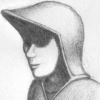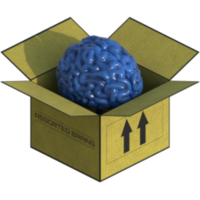Thaumaturge said:
Well, I'm thinking there less in terms of art-style than in terms of what would work on a technical level: that large areas of solid (or near-solid) colour should suffer less from being scaled down than likely would areas with lots of variation in colour
Ah yes, sure.
Basically, if you want some characteristic edge to be 2 pixels wide on screen, but your models may also be used for close up views so need more detail, you would need to figure out a scaling factor to know how wide 2 pixels are related to your geometry and texture solutions. And then, when making the art, you know that's the spatial frequency where you want to add your most characteristic designs. Anything smaller, e.g. some detailed dirt or patterns, should have low contrast. So those extra details still aid the close up views, but add no noise to the default zoomed out view.
In practice, you can just zoom out your models and textures constantly while making them. So no need to figure out such scaling factor exactly.
Personally i do this all the time anyway, but at multiple zoom levels. Ideally, the artwork is recognizable at any scale. If we make a cover for a music album, we want the name of the band to be easily readable no matter if it's a thumbnail image on a web store, or a big vinyl album cover in the hands of the customer. We also want the face of the musician to be recognizable, while it's ok if our list of hit tracks, written in small letters, is not readable on the webshop. Our list of priorities here is artist name > artist face > track list.
We can relate the task of designing the cover to something like a fourier transform, or the fbm way of summing sum up noise functions at increasing frequencies but decreasing amplitudes.
We could also use a sampling theorem to proof that high frequencies get lost as we zoom out, or if a potential customer looks at a record just for a moment, or if a gamer has to deal with fast changes on screen.
The obvious conclusion is that we want to represent important things at lower frequencies / bigger scales, and not so important details can be some eye candy, but we don't want too much of it so it becomes noise, and we don't use them to show important information.
Now we don't always have control of which details at which frequencies appear in our artworks, but if there is a problem, we often can fix it by reducing / increasing contrast, to tone them down or up in a way our intended message stands out.
This gives us the general guideline to have low variance in high frequencies, and high variance in low frequencies, to get recognizable and scalable artwork.
However, this helps us to prevent mistakes, but it does not yet help to create better art which stands out.
To do so, we may violate or exaggerate such guidelines. E.g. a comic artist may draw backgrounds with more abstractions and thinner lines than the characters. Or a game level may use monochrome, blocky walls with subtle gradients of lighting, but colorful, detailed characters, so they are easier visible.
But i like to relate this as well to math. I imagine we have a limited amount of energy, representing attention. And then we solve some optimization problem to distribute this energy, so it focuses on spots of interest. We make the interesting parts more detailed, with higher contrast and expression, so it separates clearly from the subtle background. If we have too many spots of interest, we first need to reduce their number, because attention is finite. We can not guide it everywhere, and we need priorities and compromises.
… Probably not the 'technical level' you expected to hear. ; )
Hmm… It's a possibility, but I'm loath to do so with quite so many textures, I fear…
I meant a global setting, not individually per texture. Just to have everything a bit sharper.
Though, not sure when this is actually a win. Personally i prefer smooth over sharp images, but many people love crisp and gritty stuff.







